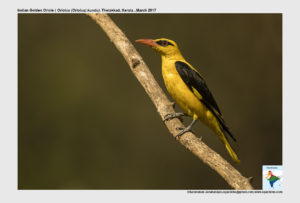
Indian Golden Oriole Oriolus oriolus kundu
Etymology:
- Oriolus : Latin word for golden oriole derived from aureoles- golden
- Oriolus : Latin word for golden oriole derived from aureoles- golden
- Kundu : Etymology undiscovered
Vernacular Names: Mar: Haldya
Distribution in India: Resident of Central and East India. Summer visitor in North, winters in South.
Description: Size of 24–25 cm; wt. of 60–95 g. The male has head, upperparts and entire underparts rich golden-yellow, black of lores extending as narrow black streak around and behind eye; upperwing is velvety black, with broad yellow tips to primary coverts forming large yellow carpal patch on folded wing. The remiges have yellowish-white tips, outer primaries and outer secondaries have narrow yellowish-white edges on outer webs , outermost tertial is tipped yellowish-white. The tail is velvety black, central pair of feathers have narrow yellow tips, terminal two-thirds of outer feathers are conspicuously golden-yellow; underwing-coverts are yellow. The iris is red; bill is dark pink; legs are slaty blue. The female is variable; commonly has head, neck, mantle and back as bright yellowish-green, rump is yellower; lores are dark, wing is green or brownish, tail is olive, outer rectrices have yellowish tips; chin to upper breast is pale grey, becoming yellowish-white on belly, all streaked blackish ,streaking heaviest on chest, undertail-coverts are bright yellow-green; bare parts as male but duller; sometimes more similar to male. The juvenile has bright golden-yellow face and upperparts, yellowish supercilium, hint of long dark eye patch, outer rectrices extensively tipped yellow, very heavy black streaking below, bill is black; first-year male as female, but often with mix of adult and immature characters
Habitat: It is found in Open deciduous and semi-evergreen forests, forest edge, woodland, thorny forest and thickets. It is found from lowland up to 4400 m.
Food Habits: It eats mainly insects, berries and fruits, especially figs, peepal ; also some nectar. It forages alone, in pairs and sometimes in small groups; sometimes joins mixed-species flocks. It is found mostly in dense canopy of trees; may drop to ground to catch insects.
Breeding Habits: They breed in April–Sept. Male calls constantly on territory during breeding season; female arrives a few days later, and courtship displays involve vigorous chases. The nest is built by female, male may collect some material. The nest is a moderately deep open cup woven from fine grass stems, leaves, hemp stems, fine roots, seed down, slender strips of bark and sometimes other materials, lined with fine grass, vegetable down, hair and feathers, bound with small amounts of spider web, often draped on outside with cobwebs, bits of papery bark, rags and other rubbish. It is suspended hammock-like in thin, horizontal forked branch at variable height, usually high in outer edge of well-foliaged tree canopy near and sometimes above water, often close to nest of aggressive Hair-crested Drongo or Black Drongo . They lay a clutch of 1–5 eggs. The incubation is done by female. The incubation period is 14–15 days. The chicks are brooded by female and fed by both sexes. The nestling period is 14–15 days The young stay with parents for 1 month after fledging.
.